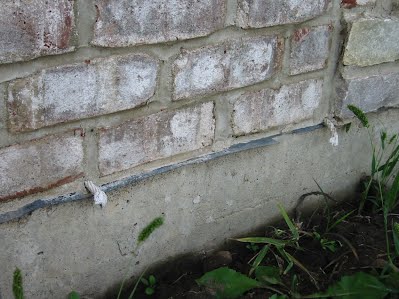The Importance of Addressing Deteriorated or Missing Caulking around Exterior Doors and Windows5/8/2023
Over time, caulking can deteriorate or go missing, leaving gaps that compromise the energy efficiency, comfort, and protection of your home. In this blog post, we'll explore the importance of addressing deteriorated or missing caulking, the consequences of neglecting this issue, and practical steps to rectify it. Let's dive in and learn how to fortify your home against the elements.
Caulking serves as a crucial barrier against moisture, air infiltration, and temperature fluctuations around doors and windows. It is a flexible material typically made of silicone or latex that fills gaps, seals joints, and prevents drafts and water penetration. Deteriorated or missing caulking around doors and windows can lead to various issues:
Addressing deteriorated or missing caulking is crucial for several reasons:
Follow these practical steps to rectify deteriorated or missing caulking:
For complex caulking projects or if you're unsure about the proper techniques, consider seeking professional assistance. Experienced contractors or window and door specialists can provide expertise and ensure optimal results, particularly for large-scale or challenging repairs. Deteriorated or missing caulking around exterior doors and windows is a matter that should not be overlooked by homeowners. Addressing this issue is essential to maintain energy efficiency, protect against moisture damage, prevent pest infestations, and enhance overall comfort within your home. By conducting regular inspections, promptly replacing deteriorated caulking, and ensuring proper sealing, you can fortify your home against the elements and enjoy a more comfortable and energy-efficient living environment. Remember, a small investment of time and effort in maintaining and repairing caulking can yield significant long-term benefits for your home's durability, efficiency, and your own peace of mind. So, seal those gaps, safeguard your home, and enjoy the comfort and protection you deserve. In this blog post, we'll explore the role of flashing, why gaps occur, the risks associated with them, and the importance of timely repairs. Let's dive in and learn how to keep your home protected from the elements.
Flashing is a crucial element in a building's envelope system, designed to prevent water penetration in vulnerable areas, such as roof valleys, chimneys, windows, and doors. It consists of thin, waterproof materials (usually metal or plastic) strategically installed to redirect water away from potential entry points. Gaps in flashing can develop due to various factors:
Gaps in flashing can have detrimental consequences for your home:
Timely repairs of gaps in flashing are essential for several reasons:
To address gaps in flashing, consider the following steps:
Gaps or missing mortar between bricks or blocks can indicate underlying mortar deterioration, which can compromise the integrity and aesthetics of your home. In this blog post, we'll explore why mortar deterioration occurs, the signs to look out for, and the importance of addressing this issue promptly. Let's dive in and learn how to preserve the strength and beauty of your brick and block exteriors.
Mortar, the material used to hold bricks or blocks together, is susceptible to deterioration over time due to various factors:
Gaps or missing mortar between bricks or blocks serve as visible indicators of mortar deterioration. Other signs to watch for include:
Promptly addressing mortar deterioration is crucial for several reasons:
To address gaps or missing mortar, consider the following actions:
Whether it's the exterior trim, decking, or interior elements, wood adds warmth and character to our homes. However, without proper protection, wood is susceptible to deterioration from the elements, pests, and moisture. In this blog post, we'll explore the importance of painting and sealing exposed wood, the benefits it offers, and practical tips to preserve its beauty and durability. Let's dive in and discover the key to maintaining your wood's longevity.
Wood is a natural material that, when exposed to the elements, can deteriorate over time. Factors such as UV rays, moisture, temperature fluctuations, and insect activity contribute to its vulnerability. Without adequate protection, wood can experience issues like rot, warping, discoloration, and structural degradation. Painting and sealing exposed wood surfaces provide several significant benefits:
Follow these practical tips to ensure effective protection for your exposed wood surfaces:
By investing time and effort into painting and sealing exposed wood, you not only protect it from deterioration but also preserve its natural beauty. A well-maintained wood surface adds value to your home, creates a welcoming atmosphere, and showcases the unique character of the material. Painting and sealing exposed wood surfaces play a crucial role in preserving their beauty, durability, and structural integrity. By providing a moisture barrier, UV protection, and pest deterrence, painting and sealing help combat the damaging effects of the elements and enhance the wood's lifespan. Remember to prepare the surface properly, select the right products, follow application guidelines, and prioritize regular maintenance. With the proper care and attention, your wood will continue to exude its natural charm while standing strong against the tests of time. Vines can add a touch of natural beauty and charm to your property, but they also come with certain considerations. In this blog post, we'll discuss the benefits and potential risks associated with vines on exterior walls, along with important factors for homeowners to consider. Let's dive in and discover the world of vines as they intertwine with your home's exterior.
Vines can offer several advantages when properly managed:
While vines can offer numerous benefits, homeowners should also be aware of potential risks and considerations:
To enjoy the benefits of vines while minimizing risks, consider the following tips:
Certain situations may require additional considerations:
The Importance of Adequate Clearance Between Siding and Ground: Why It Matters and How to Address It5/8/2023
While it may seem like a minor concern, this lack of space can lead to significant problems for your home's exterior. In this informational blog post, we'll explore the importance of adequate clearance, the potential issues it can cause, and practical solutions to address this problem. Let's dive in and ensure that your siding has the space it needs!
Adequate clearance between the bottom edge of your siding and the ground is crucial for several reasons:
Insufficient clearance between siding and the ground can lead to various problems:
Fortunately, there are practical solutions to address the issue of inadequate clearance:
Don't forget the importance of regular maintenance and inspection to ensure adequate clearance:
A topic that has gained significant attention in the realm of home construction and renovation—asbestos cement siding. Asbestos was once a commonly used material in various building applications, including siding. In this blog post, we'll explore what asbestos cement siding is, its potential risks, how to identify it, and considerations for homeowners and renovators. Let's dive in and equip ourselves with knowledge about asbestos cement siding.
Asbestos cement siding, also known as fiber cement siding, is a type of exterior cladding that was widely used from the 1930s to the 1980s. It consists of a mixture of cement and asbestos fibers, which provided strength, durability, and resistance to fire and weather conditions. Asbestos fibers were added to enhance the siding's performance and longevity. Asbestos is a naturally occurring mineral that, when disturbed, can release microscopic fibers into the air. Inhalation of these fibers can lead to serious health issues, including lung diseases and various forms of cancer, such as mesothelioma. While asbestos cement siding is considered relatively low risk when intact and undisturbed, it can become hazardous during renovations, repairs, or if the siding deteriorates over time. Identifying asbestos cement siding can be challenging without professional testing, as it closely resembles other types of fiber cement siding. However, there are some indicators that may suggest the presence of asbestos:
If you have asbestos cement siding or are considering renovations, here are some important considerations:
Stucco is a popular exterior finish known for its durability and aesthetic appeal. However, over time, cracks can develop, compromising both the appearance and functionality of the stucco. In this informational blog post, we'll explore the causes of stucco cracking, how to assess the severity of the cracks, and the available repair options. Let's dive in and equip ourselves with knowledge about stucco cracking!
Understanding the underlying causes of stucco cracking is crucial for effective prevention and repair. Some common causes include:
During a visual inspection, it's essential to assess the severity of stucco cracks to determine the appropriate course of action. Consider the following factors:
The appropriate repair method for stucco cracks depends on the severity and underlying cause. Consider the following options:
To minimize the likelihood of future stucco cracking, consider the following preventive measures:
 An often overlooked yet vital component of your home's exterior—weep holes. These small openings play a crucial role in preventing water buildup and ensuring proper drainage in various parts of your home. In this informational blog post, we'll explore the importance of weep holes, signs of blockage, and effective solutions to keep them clear and functioning optimally. Let's dive in and empower ourselves with knowledge about blocked weep holes! Weep holes are intentionally placed openings designed to facilitate drainage in areas where water accumulation may occur. Commonly found in brick walls, window sills, and exterior cladding systems, weep holes allow water to escape, preventing moisture buildup and potential damage to the structure. Understanding their importance is key to maintaining the integrity of your home's exterior. Recognizing the signs of blocked weep holes is crucial in preventing potential water damage. Keep an eye out for the following indicators:
Understanding the underlying causes of weep hole blockage is crucial for effective prevention. Common culprits include:
Preventing and addressing blocked weep holes is essential for maintaining proper drainage. Consider the following solutions:
Whether you have a brick façade, stone walls, or a concrete foundation, understanding the causes and implications of masonry cracking is essential. In this blog post, we'll discuss different types of masonry cracks, their potential causes, how to assess their severity, and the necessary steps to address them. Let's delve into the world of masonry cracking and empower ourselves to protect and maintain our homes.
Not all cracks in masonry are the same, and understanding their characteristics can provide insights into potential issues. Common types of masonry cracks include:
Understanding the underlying causes of masonry cracking is essential to address them effectively. Common culprits include:
During a home inspection, it's important to assess the severity of masonry cracks to determine the appropriate course of action. Factors to consider include:
Once you've identified masonry cracks, it's important to take appropriate action to prevent further damage. Here are some steps to consider:
|
Categories
All
|
Read Our Reviews!
Our Primary Office Locations in Ohio & North Carolina
|
Raleigh, NC
3052 Cinder Bluff Dr Raleigh, NC 27603 984-261-2787 Cleveland, Ohio
16115 Waterloo Rd Cleveland, OH 44110 216-672-6185 |
|
Ohio Service Areas
North Carolina Service Areas
|
Raleigh
Holly Springs Fuquay-Varina Angier Mt. Pleasant Smithfield Clayton Knightdale Zebulon Rollsville Wake Forest Youngsville Morrisville Carey Apex |
Durham
Chapel Hill Pittsboro Mebane |
Greensboro
High Point Ashboro |
Winston-salem
Huntsville Clemmons |
Wilmington
Wrightsboro Kings Grant Myrtle Grove Sea Breeze Carolina Beach Kure Beach Leland Castle Hayne |
Contact us at: 888-301-3186
Careers | Services
© 2024 - CAI Home Inspection & Engineering. All rights reserved. Privacy Policy.
Careers | Services
© 2024 - CAI Home Inspection & Engineering. All rights reserved. Privacy Policy.

 RSS Feed
RSS Feed






